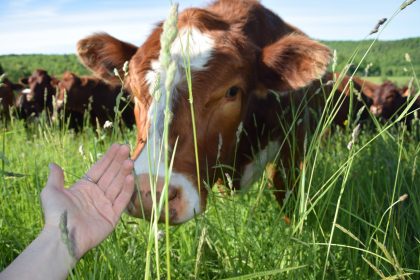
At Vermont’s Vershire Farm, Niko Horster trusts his cattle to help correct the imbalances they uncover in the soil and the grasses on his central Vermont pastures.
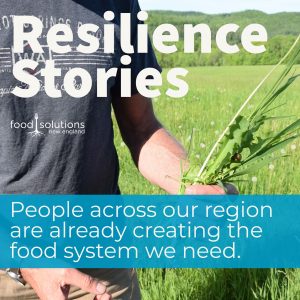 One in a series of Resilience Stories from around New England, sharing examples of how people across our region have already been actively working on creating a just, sustainable and resilient food system in a variety of ways.
One in a series of Resilience Stories from around New England, sharing examples of how people across our region have already been actively working on creating a just, sustainable and resilient food system in a variety of ways.
Instead of providing a one-size-fits-all mineral lick that would work like a multi-vitamin in a human, Horster gives his cows a plain salt lick and a smorgasbord of individual nutrients ranging from cobalt to selenium. They take what they need for themselves and help spread that wealth of minerals around the approximately 100 acres they roam rotationally.
When he was first testing out this system a few years back, the cows were unexpectedly chowing down on iodine. “Uh oh, that is not a nutrient they need a lot of, and I [feared] they might keel over,” said Horster. But tests conducted on the plants in the paddock where the cows were grazing showed evidence of being grown in soil deficient in iodine. Since the cattle went on to naturally fertilize that field with the extra iodine that passed through their systems, the problem was solved.
“We still don’t know what actually happened. But what we do know is whatever they were eating was deficient in some way. We let the cows [address the problem], because they know much better what’s missing than I do,” said Horster.
Descendants of a chestnut-hided continental breed recognized by a thick white stripe that runs the length of their backs and then up to their bellies, the cows grass-fed and finished by Horster and sold by Shire Beef company have been bred to mature on pasture in harsh climates to render lean, but still tender, meat. Horster has been raising them for over 15 years using regenerative agriculture practices.
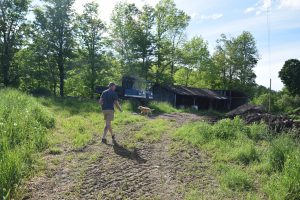
Shire Beef contributes high-quality beef to the regional food system through wholesale accounts to local restaurants and direct sales to Horster’s neighbors. Core to his operation is a seasonal rotational grazing scheme that steers animals around the acres he owns and leases in this part of the Upper Connecticut River Valley corridor. This holistically managed process, Horster insists, makes for a happy, healthy herd of about 50 animals as they feast on perennial grasses for six months of the year, never left long enough in one spot to nibble the greenery low enough to expose bare ground. Equally beneficial is the fact that circulating animals enrich soil that was depleted by conventional farming methods practiced on it for decades. Horster, who holds a PhD in Philosophy of Science and Logic, knows healthy soil pulls carbon out of the atmosphere, a process that can help fight climate change. He is working to foster a variety of grasses with deeper root systems to make this carbon sink a lasting proposition in this corner of the regional foodscape.
Horster is also keen to prove, with scientific certainty, that food raised in and on regenerated soil is more nutrient-dense than food grown in and on soil depleted by conventional farming methods involving synthetic fertilizers and annual monocrops like hay, corn, and soybeans. Food justice, he contends, must account for the quality, and not just the quantity, of food consumed by humans across social and economic divides.
Prior to the pandemic, Horster set up a regular Saturday-morning distribution point at the town landfill – a necessary weekly stop for many rural residents that often doubles as very social time — to sell his flavorful and nutrient-dense beef to neighbors at the same price his largest wholesale customers enjoyed. Like many localized meat producers in New England, Horster saw his sales increase in the early part of the pandemic as the national beef supply chain experienced processing and distribution issues. Disappointingly, sales in the spring of 2021, were the worst he’s had on record as restaurants were not fully operational and retail customers were drawn back to the convenience of conventionally produced meat available in grocery stores.
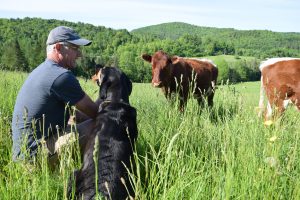
Horster and his wife Liana, a faculty member at The Mountain School of Milton Academy, a residential farming program for high school students located down the road from Vershire Farm, have recently opened their land to the herd of Bison cared for by the Nulhegan Band of the Coosuk Abenaki Nation. The partnership will enrich the soil on Shire Farm and give the tribe an avenue to fight food insecurity and preventable diet-related disease using a food source consumed by their ancestors since time immemorial. The Abenaki presence on Shire Farm will include vegetable production, as well as an on-farm retail and education space for tribal artisans to offer public workshops in traditional arts like black ash basket making and porcupine quill embroidery.
Animals as Part of an Integrated Land Management Approach
Horster has worked to develop a detailed permaculture plan to increase the biodiversity of animal, plant, and microbial life on his land. For example, some of Vershire Farm’s pastures have slopes approaching a 30% grade. To increase water retention on those, he created a swale and berm system to slow water runoff and planted daikon radish seed into the furrows. This technique increased water penetration into the soil from 8-12 inches to over 24 inches, leading to increased soil fertility and deeper root systems running through them. Also, on the edges of lower fields that were historically wet, Horster planted willow trees and several types of shrubs whose roots help absorb the water in the spring but also help buffer the summer winds to slow evaporation in the fields come August.
The end game is to create conditions in which a wide variety of grasses can thrive, thereby creating a network of roots, bacteria, and mycorrhizal fungi that support a healthy underground carbon exchange.
“The [animals] we have here are essentially land management tools,” said Horster. Cattle are herded, often daily, between small paddocks within larger pastures. This movement guards against overgrazing, stimulates plant growth, gives the animals a more diverse diet, ensures even distribution of manure, and minimizes the animals’ exposure to any potential parasites in that manure. Horster tracks how long the cows graze in any given area (how many, how large an area) and what the weather parameters (precipitation, temperature) were at any given time so he can make better-informed decisions about setting future forage grasses and grazing plans.
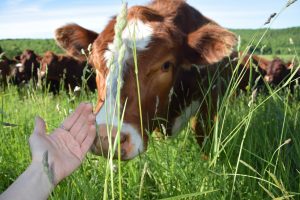
Horster points to the work of North Dakota rancher Gabe Brown, featured in the 2020 Netflix documentary film “Kiss the Ground”, as a regenerative agricultural rock star who stresses the role of seasonal grazing animals, coupled with low till and no-till and rotational crop farming techniques, as a key ingredient to rebuilding healthy topsoil on the 5,000 acres he owns just outside of Bismarck. The percentage of organic matter in Brown’s soil have increased from about two percent in 1991 when he acquired the land to over six percent today. He’s seen water retention rates grow from 1/2 inch per hour in 1991 to eight inches per hour today. On the matter of carbon retention, Brown’s soils have 96 tons of carbon per acre in the top 48 inches, compared to the 10 to 30 tons of stored carbon typical on conventionally farmed soils in the same region.
Horster has not hit numbers like Brown’s yet. But he is still researching ways to get there. With the help of a USDA grant and soil scientist from Dartmouth University and the University of Vermont Cooperative Extension, he’s brought perennial wheatgrass called Kernza into the mix on his farm. Developed by the Kansas-based non-profit Land Institute, this grass could grow to be a significant source of protein for Horster’s cattle while its roots, which can extend 10-feet into the soil, can serve as a means of sinking carbon that deep as well.
Growing Better Food
Horster circles back to his assertion that soil rich in carbon is soil rich in nutrients. “An apple a day kept the doctor away from the 1930s. Now they say it takes six apples to get the same amount of nutrients. There’s no food in our food,” he says.
Horster wants to start measuring the nutrient density of meat. He wants to take beef culled from the same breed of cattle but reared on farms with different degrees of soil health. Does soil health matter to the nutritional value of beef culled from grass-fed cattle? Horster doesn’t know yet as he’s asked 15 USDA-certified labs to conduct tests like these and has been told they don’t have the capability to do that.
But he’s hopeful about work spearheaded by organic farmer Dan Kittredge of the Bionutrient Food Association, a nonprofit educational organization dedicated to increasing quality in the food supply, to create a handheld sensor to measure nutrient density. This technology, currently in a prototype stage, is expected to be on the market within the next three years. When consumers can point a beam of light at a display of vegetables in a grocery store and know how to select for the most nutritious one, Horster says, that will be a game-changer for regenerative agriculture in America.
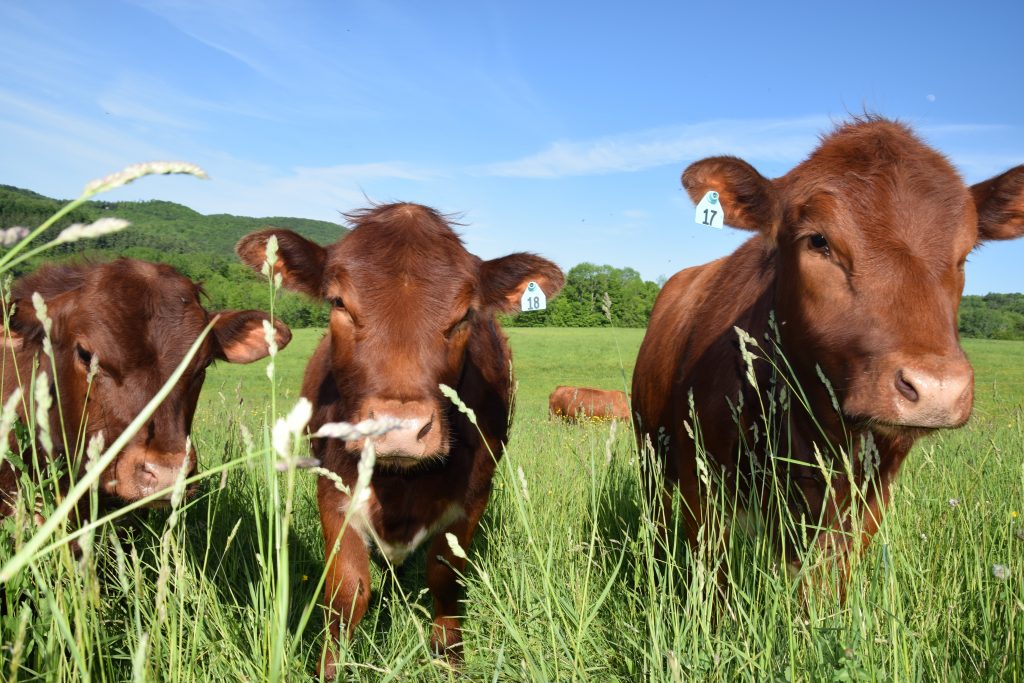
Back to the Resilience Stories main page.




